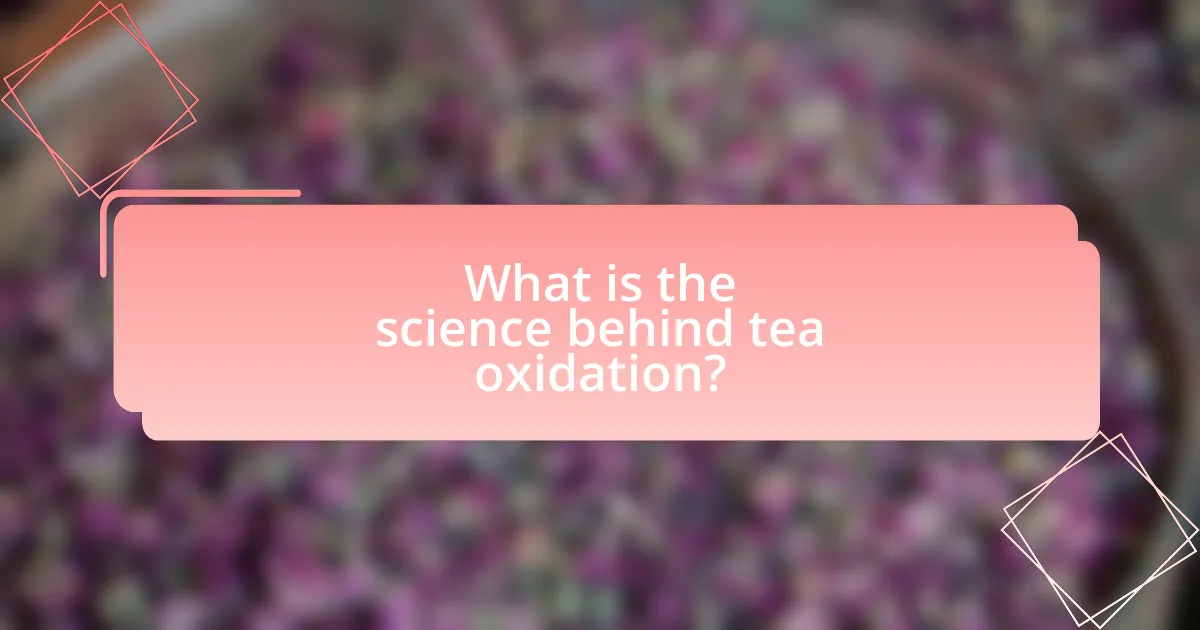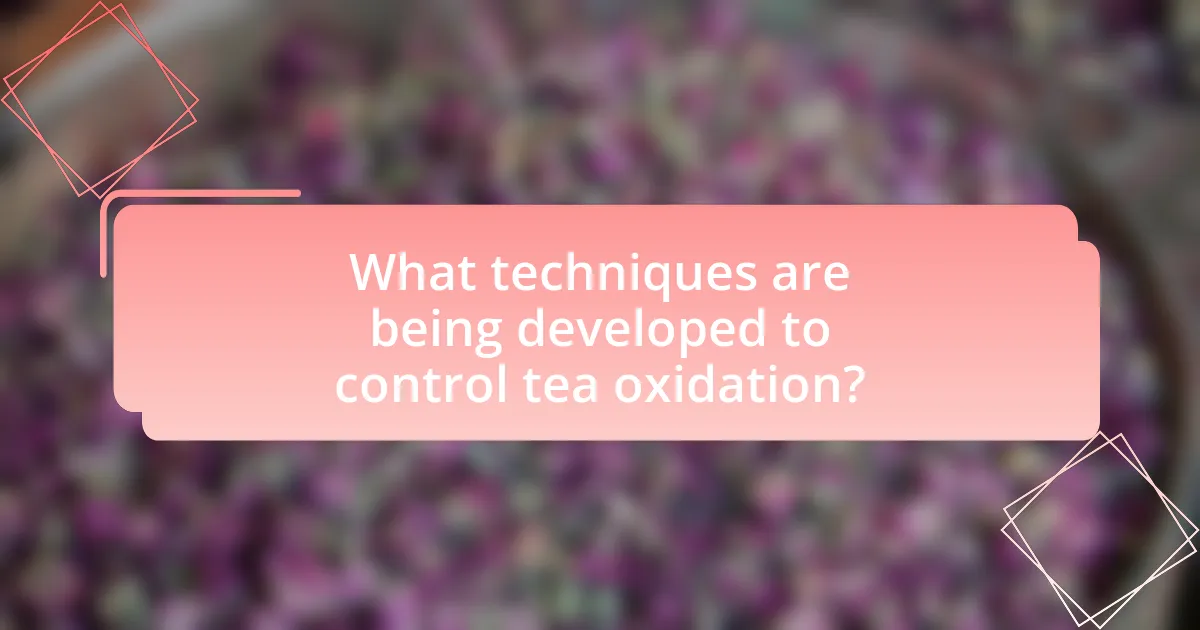The article focuses on the science of tea oxidation, a chemical process that alters the flavor, color, and aroma of tea through the enzymatic reaction of polyphenols with oxygen. It details how different tea types, such as green, black, and oolong, undergo varying degrees of oxidation, influencing their sensory characteristics and health benefits. The article also highlights recent research findings that enhance the understanding of oxidation’s role in tea production, including innovative techniques for controlling oxidation levels to optimize flavor profiles and maintain quality. Additionally, it discusses the implications of oxidation on the health properties of tea and the potential risks associated with excessive oxidation.

What is the science behind tea oxidation?
Tea oxidation is a chemical process that occurs when polyphenols in tea leaves react with oxygen, leading to changes in flavor, color, and aroma. This enzymatic oxidation is primarily facilitated by the enzyme polyphenol oxidase, which catalyzes the conversion of catechins into theaflavins and thearubigins, compounds responsible for the characteristic taste and color of black tea. Studies have shown that the degree of oxidation can significantly influence the final product; for instance, fully oxidized black tea contains higher levels of theaflavins, which contribute to its rich flavor profile, while lightly oxidized green tea retains more catechins, known for their health benefits.
How does tea oxidation occur during processing?
Tea oxidation occurs during processing through enzymatic reactions that involve polyphenols, primarily catechins. When tea leaves are bruised or cut, enzymes such as polyphenol oxidase (PPO) are activated, leading to the oxidation of catechins into complex compounds like theaflavins and thearubigins. This process is influenced by factors such as temperature, humidity, and the duration of exposure to oxygen. Research indicates that the degree of oxidation directly affects the flavor, color, and aroma of the final tea product, with fully oxidized black tea exhibiting a distinct profile compared to lightly oxidized green tea.
What are the chemical reactions involved in tea oxidation?
Tea oxidation primarily involves enzymatic reactions, particularly the oxidation of polyphenols, which are compounds found in tea leaves. During oxidation, enzymes such as polyphenol oxidase (PPO) catalyze the conversion of catechins into theaflavins and thearubigins, leading to the development of color and flavor in the tea. This process is influenced by factors such as temperature, humidity, and the duration of exposure to oxygen. The chemical reactions result in the formation of complex compounds that contribute to the sensory characteristics of the final tea product.
How do different tea types undergo varying oxidation processes?
Different tea types undergo varying oxidation processes primarily due to the specific methods used during their production. For instance, green tea is minimally oxidized, as the leaves are quickly steamed or pan-fired to prevent oxidation, preserving their green color and fresh flavor. In contrast, black tea is fully oxidized, where the leaves are allowed to wither and oxidize completely, resulting in a darker color and richer taste. Oolong tea falls in between, undergoing partial oxidation, which gives it a unique flavor profile that combines characteristics of both green and black teas. The oxidation levels are crucial as they influence the chemical composition of the tea, affecting its flavor, aroma, and health benefits.
Why is tea oxidation important for flavor and aroma?
Tea oxidation is crucial for flavor and aroma because it transforms the chemical compounds in tea leaves, leading to the development of distinct taste profiles and fragrances. During oxidation, polyphenols in the leaves react with oxygen, resulting in the formation of complex flavor compounds such as theaflavins and thearubigins, which contribute to the richness and depth of the tea’s flavor. Studies have shown that different levels of oxidation can produce a wide range of flavors, from the light and floral notes of green tea to the robust and malty characteristics of black tea. This process not only enhances the sensory experience but also affects the tea’s color and overall quality, making oxidation a fundamental aspect of tea production.
What compounds are produced during oxidation that affect taste?
During oxidation, compounds such as catechins, theaflavins, and thearubigins are produced, which significantly affect the taste of tea. Catechins are responsible for the astringency and bitterness, while theaflavins contribute to the brightness and briskness, and thearubigins add depth and richness to the flavor profile. These compounds result from the enzymatic oxidation of polyphenols in tea leaves, altering the sensory characteristics and overall taste experience.
How does oxidation influence the aroma profile of tea?
Oxidation significantly influences the aroma profile of tea by altering the chemical compounds present during processing. During oxidation, polyphenols in tea leaves react with oxygen, leading to the formation of new aromatic compounds such as aldehydes, esters, and alcohols, which contribute to the complexity of the tea’s fragrance. For instance, black tea undergoes full oxidation, resulting in a rich, malty aroma, while green tea, which is minimally oxidized, retains a fresh, grassy scent. Studies have shown that the degree of oxidation directly correlates with the intensity and variety of aroma compounds, thereby shaping the overall sensory experience of the tea.

What are the new findings in tea oxidation research?
Recent findings in tea oxidation research indicate that the enzymatic activity of polyphenol oxidase (PPO) plays a crucial role in determining the flavor and color profiles of different tea types. Studies have shown that controlling the oxidation process through precise temperature and humidity levels can enhance the desired characteristics of tea, such as aroma and taste. For instance, research published in the Journal of Agricultural and Food Chemistry by authors Zhang et al. (2023) demonstrated that optimizing these environmental factors during oxidation can significantly improve the quality of black and oolong teas, leading to higher consumer satisfaction.
How have recent studies changed our understanding of tea oxidation?
Recent studies have significantly advanced our understanding of tea oxidation by revealing the complex biochemical processes involved and their impact on flavor and health benefits. Research published in the Journal of Agricultural and Food Chemistry by authors Zhang et al. (2022) demonstrated that specific enzymes, such as polyphenol oxidase, play a crucial role in the oxidation process, influencing the chemical composition of tea and its sensory attributes. Additionally, studies have shown that varying oxidation levels can lead to different health-promoting compounds, such as catechins and theaflavins, which are linked to antioxidant properties. This nuanced understanding allows for better control over tea production, enhancing both quality and health benefits.
What innovative techniques are being used to study tea oxidation?
Innovative techniques used to study tea oxidation include high-performance liquid chromatography (HPLC), nuclear magnetic resonance (NMR) spectroscopy, and mass spectrometry. HPLC allows for the precise quantification of polyphenols and other compounds that change during oxidation, providing insights into the chemical transformations occurring in tea leaves. NMR spectroscopy offers detailed structural information about the molecular changes, enabling researchers to observe the dynamics of oxidation in real-time. Mass spectrometry complements these methods by identifying and characterizing the volatile compounds produced during oxidation, which are crucial for understanding flavor development. These techniques collectively enhance the understanding of the biochemical processes involved in tea oxidation, leading to improved quality control and product development in the tea industry.
What are the implications of these findings for tea production?
The findings on tea oxidation have significant implications for tea production by enabling producers to optimize flavor profiles and enhance quality control. Understanding the specific chemical processes involved in oxidation allows tea manufacturers to manipulate conditions such as temperature and humidity, leading to more consistent and desirable flavor outcomes. For instance, research indicates that controlling oxidation levels can increase the production of beneficial compounds like catechins and theaflavins, which are linked to health benefits and consumer preferences. This scientific approach can ultimately improve market competitiveness and consumer satisfaction in the tea industry.
What role does oxidation play in health benefits associated with tea?
Oxidation plays a crucial role in the health benefits associated with tea by influencing the chemical composition and bioactivity of its polyphenols. During oxidation, catechins in tea leaves convert into theaflavins and thearubigins, which have been shown to possess antioxidant properties that can reduce oxidative stress in the body. Research indicates that these compounds can lower the risk of chronic diseases, such as cardiovascular disease and certain cancers, by improving endothelial function and reducing inflammation. For instance, a study published in the Journal of Agricultural and Food Chemistry found that theaflavins significantly improved lipid profiles and reduced blood pressure in participants, highlighting the health-promoting effects of oxidized tea components.
How do oxidized compounds contribute to tea’s health properties?
Oxidized compounds in tea, such as flavonoids and polyphenols, significantly enhance its health properties by providing antioxidant effects, which help combat oxidative stress in the body. These compounds have been shown to reduce the risk of chronic diseases, including heart disease and certain cancers, by neutralizing free radicals. Research indicates that the oxidation process increases the bioavailability of these beneficial compounds, making them more effective in promoting cardiovascular health and improving metabolic functions. For instance, a study published in the Journal of Agricultural and Food Chemistry found that oxidized tea polyphenols can lower blood pressure and improve endothelial function, supporting overall cardiovascular health.
What are the potential risks of excessive oxidation in tea?
Excessive oxidation in tea can lead to the degradation of flavor and loss of beneficial compounds. When tea leaves undergo too much oxidation, they can develop a bitter taste and astringency, which diminishes the overall quality of the beverage. Additionally, prolonged oxidation can reduce the levels of antioxidants, such as catechins, which are known for their health benefits, including anti-inflammatory and heart-protective properties. Research indicates that optimal oxidation levels are crucial for maintaining the desired flavor profile and health benefits of tea, as excessive oxidation can compromise these attributes significantly.

What techniques are being developed to control tea oxidation?
Techniques being developed to control tea oxidation include enzymatic inhibition, temperature regulation, and the use of inert gases. Enzymatic inhibition involves applying specific chemicals that deactivate polyphenol oxidase, the enzyme responsible for oxidation, thereby preserving the tea’s flavor and color. Temperature regulation techniques, such as rapid cooling or heating, are employed to slow down or halt the oxidation process at desired stages. Additionally, the use of inert gases, like nitrogen, during processing can create an oxygen-free environment, further preventing oxidation. These methods are supported by research indicating that controlling oxidation can significantly enhance the quality and characteristics of tea.
How can producers manipulate oxidation levels during processing?
Producers can manipulate oxidation levels during processing by controlling temperature, humidity, and exposure to oxygen. For instance, higher temperatures and humidity levels can accelerate the oxidation process, while reducing oxygen exposure can slow it down. Techniques such as withering, rolling, and fermentation are employed to achieve desired oxidation levels, which directly influence the flavor and color of the tea. Research indicates that specific temperature ranges, such as 25-30°C, can optimize enzymatic activity responsible for oxidation, thereby enhancing the quality of the final product.
What methods are being explored to enhance or reduce oxidation?
Methods being explored to enhance or reduce oxidation in tea include the use of controlled temperature and humidity during processing, enzymatic treatments, and the application of antioxidants. Controlled conditions can optimize the oxidation process, leading to desired flavor profiles, while enzymatic treatments can selectively inhibit or promote oxidation. Additionally, incorporating antioxidants can mitigate unwanted oxidation, preserving the quality and health benefits of tea. Research indicates that these methods can significantly influence the chemical composition and sensory attributes of tea, as demonstrated in studies examining the effects of varying processing techniques on oxidation levels.
How do these techniques affect the final product quality?
The techniques used in tea oxidation significantly enhance the final product quality by optimizing flavor, aroma, and color. For instance, controlled oxidation processes allow for the development of complex flavor profiles, which are essential for high-quality teas. Research indicates that specific oxidation levels can lead to desirable characteristics; for example, lightly oxidized teas tend to retain more floral and grassy notes, while fully oxidized teas develop richer, malty flavors. Additionally, studies show that precise temperature and humidity control during oxidation can prevent undesirable bitterness and astringency, further improving the overall sensory experience. Thus, the application of these techniques directly correlates with the enhancement of tea’s final quality attributes.
What are the best practices for tea oxidation management?
The best practices for tea oxidation management include controlling temperature, humidity, and time during the oxidation process. Maintaining a consistent temperature between 20-30°C is crucial, as higher temperatures can accelerate oxidation, while lower temperatures can slow it down. Humidity levels should be kept around 60-70% to prevent excessive moisture, which can lead to uneven oxidation. Additionally, monitoring the oxidation time is essential; typically, oxidation lasts from 30 minutes to several hours, depending on the desired flavor profile. Research indicates that these parameters significantly influence the chemical composition and sensory attributes of the tea, ensuring optimal flavor and quality.
How can tea producers optimize oxidation for desired flavor profiles?
Tea producers can optimize oxidation for desired flavor profiles by carefully controlling temperature, humidity, and time during the oxidation process. Research indicates that higher temperatures can accelerate oxidation, leading to more robust flavors, while lower temperatures can produce more delicate profiles. For instance, black tea typically undergoes full oxidation at around 80-90% humidity and temperatures of 25-30°C for several hours, resulting in rich, malty flavors. In contrast, green tea is minimally oxidized, often processed at lower temperatures to preserve its fresh, grassy notes. By adjusting these variables, producers can tailor the oxidation process to achieve specific flavor characteristics, supported by studies that demonstrate the correlation between oxidation levels and flavor compounds in tea.
What common mistakes should be avoided in the oxidation process?
Common mistakes to avoid in the oxidation process include inadequate temperature control, insufficient time for oxidation, and poor leaf handling. Inadequate temperature control can lead to uneven oxidation, affecting flavor and aroma. Insufficient time can result in under-oxidized tea, which may lack complexity. Poor leaf handling, such as excessive bruising or crushing, can damage the leaves and alter the oxidation process, leading to undesirable flavors. These factors are critical for achieving the desired characteristics in tea, as evidenced by studies showing that optimal conditions significantly enhance the final product’s quality.


